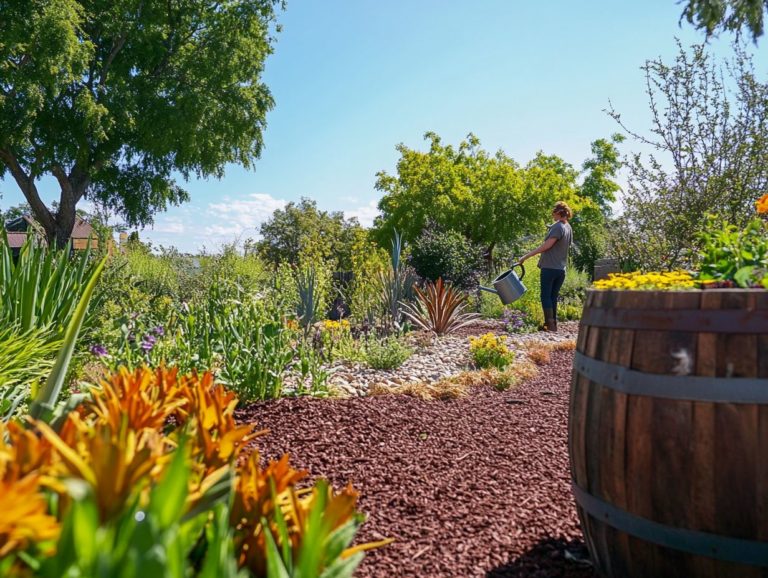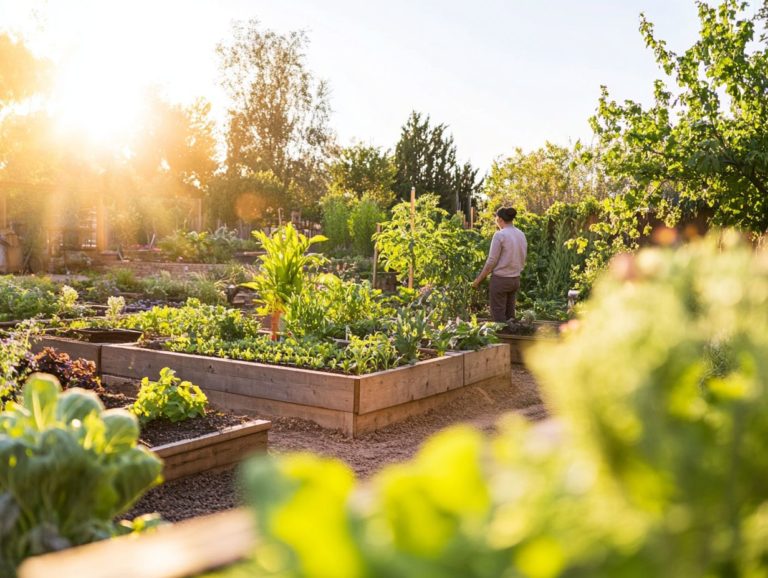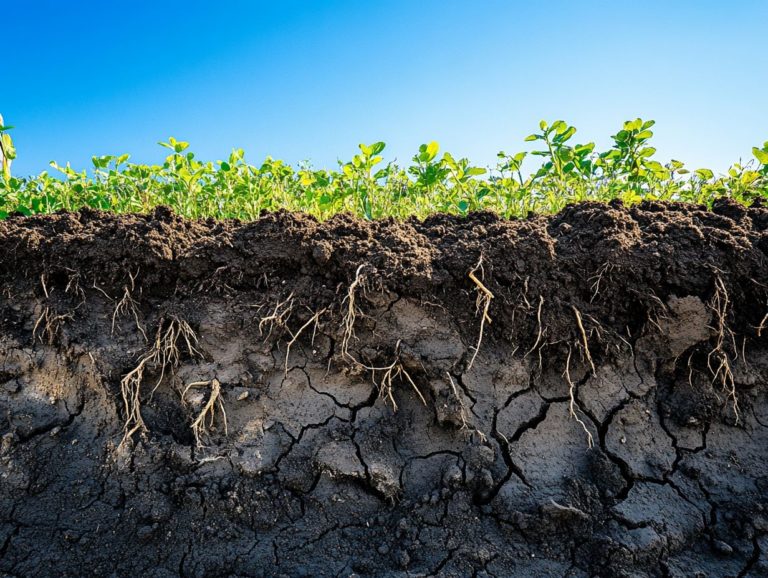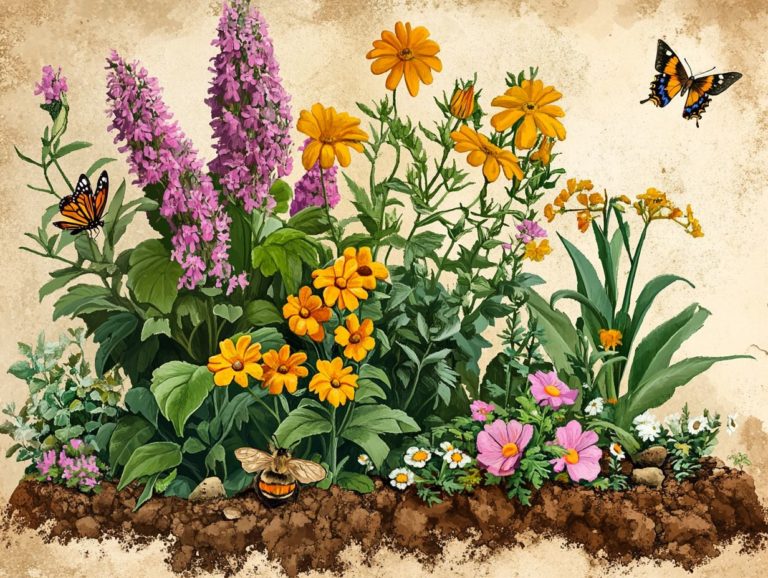5 Methods for Improving Soil Aeration
Healthy soil serves as the cornerstone of vibrant plant life. However, many gardeners often overlook the vital importance of soil aeration.
When you prioritize proper aeration, you enhance nutrient absorption, promote robust root growth, and prevent soil compaction. All of these factors contribute to thriving greenery.
This article explores five effective methods to improve soil aeration. Techniques include incorporating organic matter, utilizing cover crops, and recognizing the significance of mulching alongside manual aeration practices.
You ll discover the advantages of aeration tailored to various soil types, learn to identify signs of poor aeration, and find out the best timing for these essential practices.
Whether you re a seasoned gardener or just starting your journey into the world of plants, mastering these techniques will empower you to cultivate a flourishing garden.
Contents
- Key Takeaways:
- 1. Incorporating Organic Matter into the Soil
- 2. Using Cover Crops
- 3. Avoiding Over-Tilling
- 4. Mulching
- 5. Aerating the Soil Manually
- Why Is Soil Aeration Important for Plant Growth?
- Frequently Asked Questions
- 1. What are the benefits of improving soil aeration?
- 2. What are some natural ways to improve soil aeration?
- 3. What are the 5 methods for improving soil aeration?
- 4. Can tilling or aerating the soil improve soil aeration?
- 5. How can soil amendments improve soil aeration?
- 6. Are there any specific plants or crops that can help improve soil aeration?
Key Takeaways:
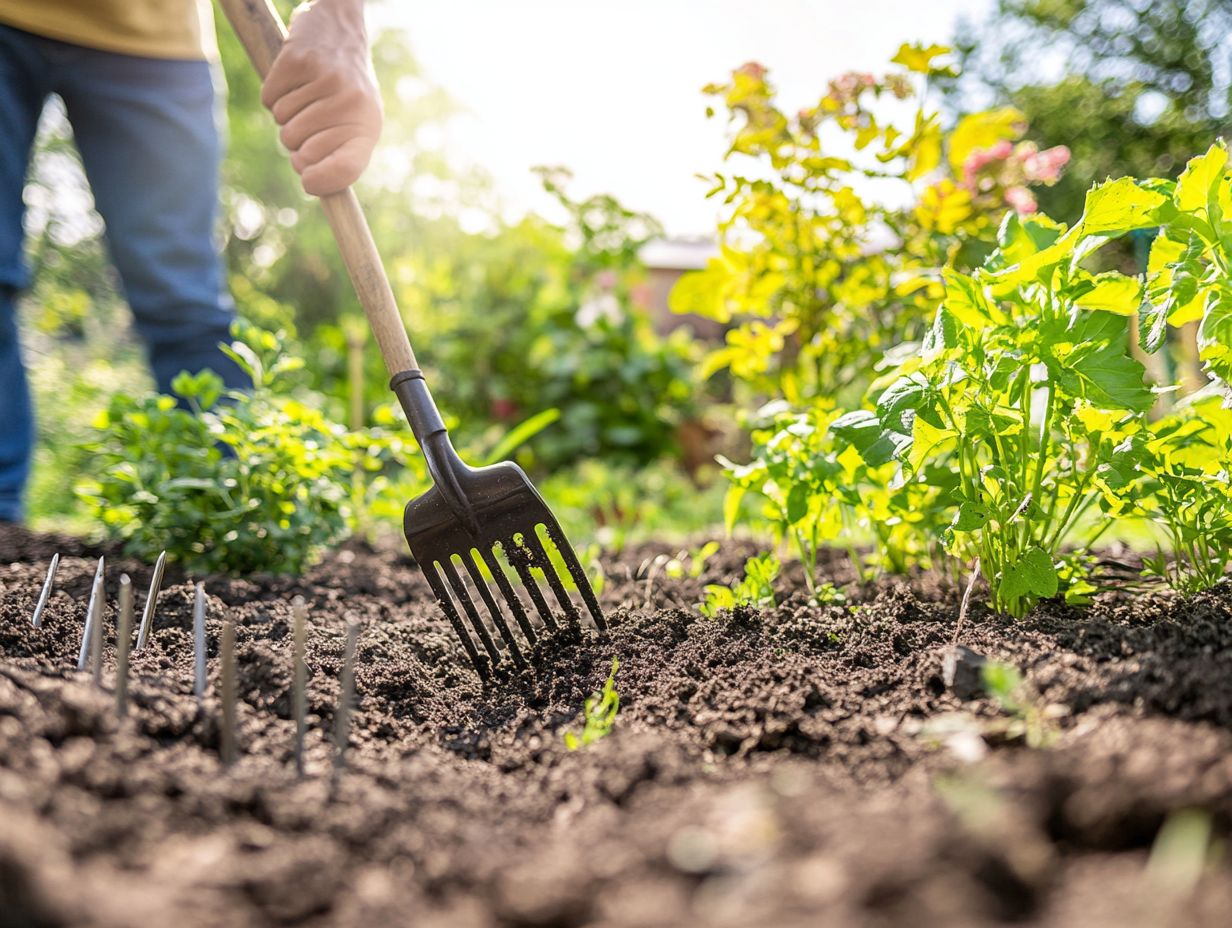
- Add organic matter for rich nutrients and lively soil!
- Cover crops protect the soil and add organic matter, providing natural aeration and improving soil health!
- Avoid over-tilling to prevent soil compaction and support plant growth!
1. Incorporating Organic Matter into the Soil
Incorporating organic matter into your soil is a fundamental practice that enhances soil health. This directly influences plant development, root growth, and overall crop productivity. Organic matter enriches the soil ecosystem, improving its structure, increasing moisture content, and fostering beneficial microbial activity.
As you enhance nutrient cycling and support earth-dwelling organisms, you’ll see less soil compaction, creating a thriving environment for your plants!
This essential component can include materials like compost, derived from decomposed organic waste, or green manure, specifically grown to be tilled back into the soil. These organic amendments not only supply essential nutrients but also nurture healthy microbial communities vital for breaking down complex organic compounds into forms that plants can easily access.
Incorporating these materials leads to improved soil aeration and drainage, both of which are vital for healthy plant roots and optimal crop yields. Effective tillage methods can further enhance these results. Using organic matter fosters a vibrant soil ecosystem, ensuring your crops receive adequate nutrition while supporting biodiversity, the variety of plant and animal life in a particular habitat, and resilience against pests and diseases.
2. Using Cover Crops
Utilizing cover crops is a strategic farming technique that significantly enhances soil fertility, controls erosion, and improves moisture content. All of these factors support healthy vegetation and boost crop productivity.
Various types of cover crops, including legumes, grasses, and brassicas, play a crucial role in nutrient absorption and soil enhancement. For instance, planting legumes like clover and vetch fixes atmospheric nitrogen, enriching the soil and making those nutrients readily available for your subsequent crops.
- Grasses, such as rye, excel at preventing soil erosion thanks to their extensive root systems that effectively bind the soil together.
- Brassicas, like radishes, break up compacted soil layers, which improves water infiltration and aeration.
By fostering a thriving ecosystem filled with beneficial microorganisms, cover crops significantly contribute to soil health, making it more resilient and sustainable over time.
In conclusion, focusing on soil aeration is crucial for a thriving garden. Implementing these methods, along with 5 ways to enhance soil fertility naturally, will not only improve your soil health but also enhance your gardening success!
3. Avoiding Over-Tilling
Avoiding over-tilling is essential for keeping your soil healthy and preventing compaction, which occurs when soil becomes too dense, making it hard for roots to grow. This compaction can significantly hinder root growth and nutrient absorption in your crops.
When you excessively till the soil, its natural structure breaks down. This leads to a loss of aeration and moisture retention. A hardpan layer can form beneath the surface, restricting root penetration and disrupting the habitat for beneficial microorganisms vital for soil vitality.
To counteract these issues, adopt alternative tillage methods like no-till farming or reduced tillage strategies. These practices preserve soil structure, enhance organic matter levels, and promote a balanced nutrient profile. They steadily improve the sustainability of your agricultural endeavors.
4. Mulching
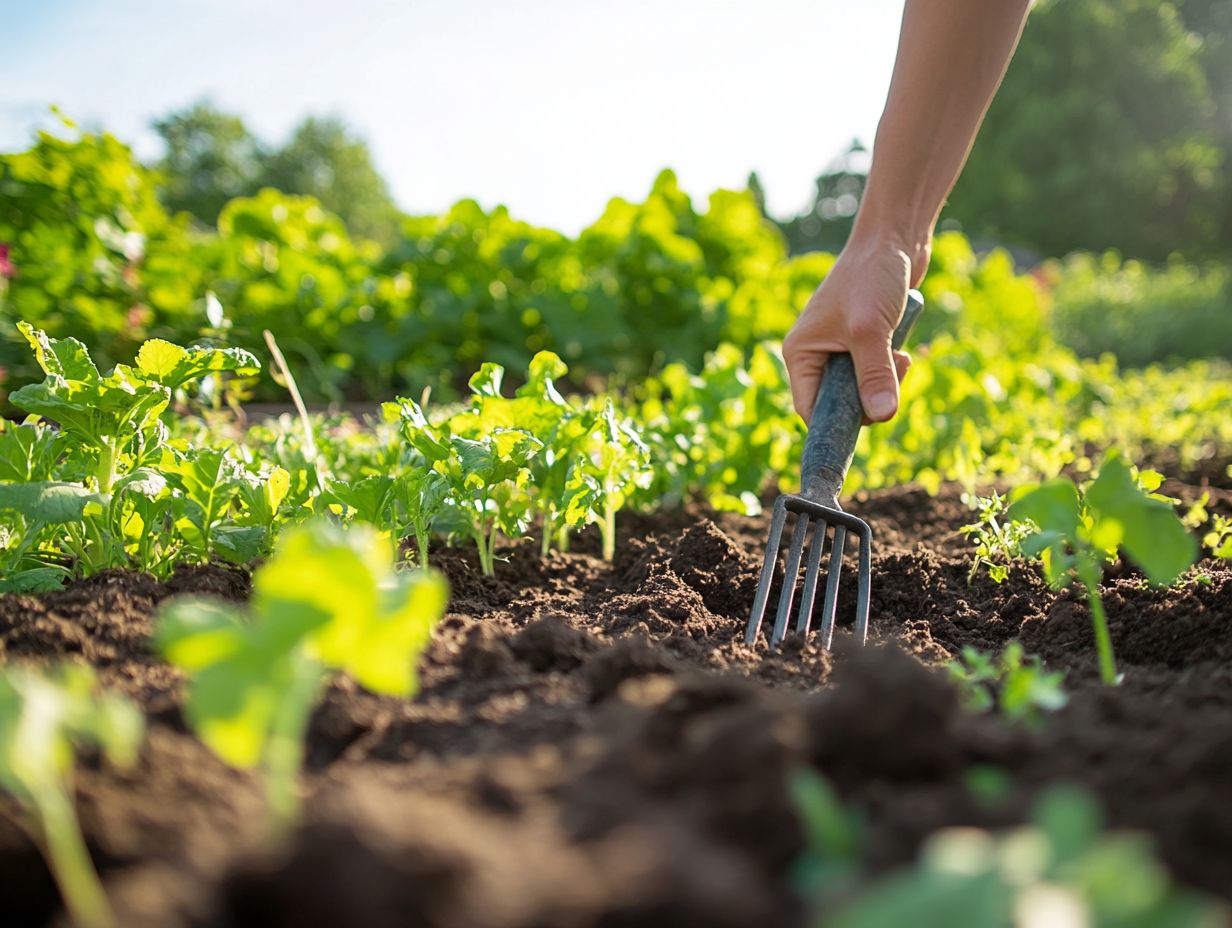
Mulching works wonders for your garden! It effectively retains moisture, enhances soil structure, and provides organic matter. All these factors promote healthy vegetation, enhance soil fertility, and improve overall soil health.
You can choose from various materials for mulching, including wood chips, straw, grass clippings, and shredded leaves. Each offers unique benefits. For example, organic mulches break down over time, enriching the soil with essential nutrients while improving its characteristics.
Beyond conserving moisture, these materials play a vital role in erosion control. They form a protective barrier against water runoff and wind. By fostering a robust root system, mulching encourages beneficial organisms that contribute to a thriving soil ecosystem and create a harmonious environment for plant growth.
The advantages of mulching go well beyond mere aesthetics! It significantly supports ecological balance, making it a practice worth embracing.
5. Aerating the Soil Manually
Manual aeration of the soil is a crucial technique! It enhances oxygen supply and oxygen saturation, alleviates compaction, and creates a thriving environment for root growth and nutrient absorption.
Utilizing methods like core aeration (removing small plugs of grass and soil) and spike aeration significantly boosts soil health. These practices create channels that allow air to penetrate deeper soil layers while promoting moisture retention for nutrient-rich plants.
Aeration supports beneficial microorganisms that thrive in well-aerated environments. These microorganisms break down organic matter, fostering a richer, more fertile soil ecosystem.
The increased microbial activity enhances soil structure and nutrient cycling. This ultimately benefits the plants that depend on this healthy foundation.
Why Is Soil Aeration Important for Plant Growth?
Soil aeration is crucial for your plants growth! It enhances oxygen saturation in the soil, encouraging robust root development and promoting overall vegetation health. This supports a vibrant soil ecosystem.
When you ensure that the soil is adequately aerated, you allow roots to access the oxygen and carbon dioxide they need. This facilitates the absorption of vital nutrients during their growth cycle, setting the stage for your plants to flourish. An oxygen-rich environment encourages the activity of beneficial microorganisms, which are crucial for nutrient cycling.
On the flip side, if soil aeration is lacking, it leads to compaction. This restricts root development and creates nutrient imbalances. Compaction hinders water infiltration and produces anaerobic pockets. Such conditions negatively impact microbial life and diminish the overall fertility of your soil.
Now is the perfect time to aerate your soil! Your plants will thank you!
What Are the Signs of Poor Soil Aeration?
Is your garden struggling? Poor soil aeration might be the culprit! Signs of poor soil aeration are unmistakable: you may notice reduced root growth, visible soil compaction, and an overall decline in your vegetation’s health. These symptoms all point to an insufficient oxygen supply, which can have a detrimental environmental impact.
Among these signs, wilted plants often catch your eye, appearing to plead for moisture while hinting at deeper issues tied to soil health. Slow growth is another clear indicator, resulting in stunted plants that struggle to reach their full potential.
These symptoms collectively serve as critical signals for you as a farmer. They underscore the necessity for timely interventions, such as implementing soil aeration techniques or applying organic amendments, to enhance fertility and restore a balanced ecosystem. By tackling these issues proactively, you can significantly boost your crop resilience and yield, ensuring a flourishing harvest.
How Does Soil Aeration Benefit Different Types of Soil?
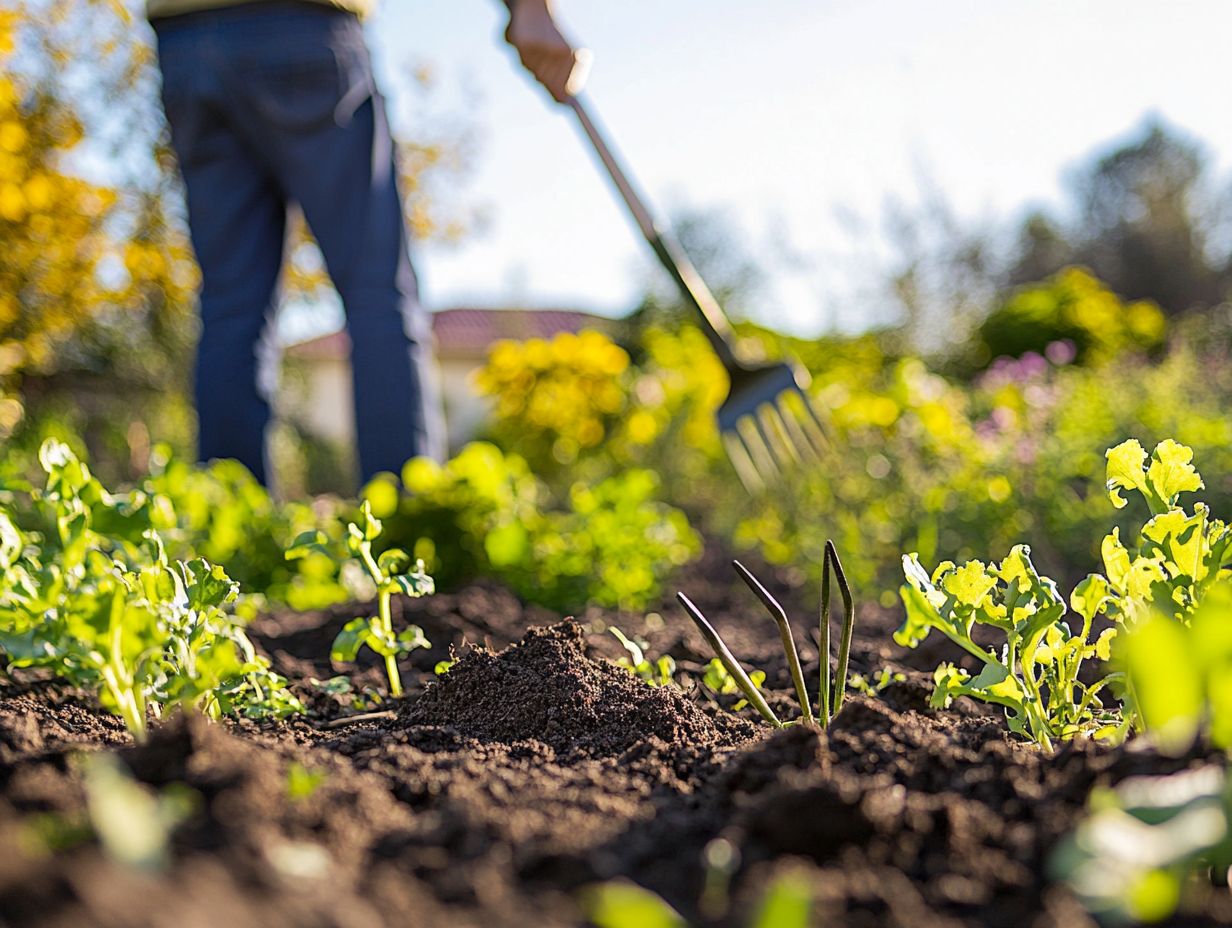
Soil aeration offers remarkable benefits across different soil types, including clay and sandy soils. It enhances soil texture and boosts nutrient absorption both vital for healthy plant development.
Sandy soils, which drain quickly, also benefit from aeration. This promotes enhanced moisture retention and nutrient uptake, while improving the overall soil texture and health.
You ll find that distinct soil types respond uniquely to aeration techniques, which in turn influence their nutrient dynamics and water retention. For example, dense clay soils can reap significant rewards from aeration. It breaks up those compacted layers, leading to improved drainage and better root penetration.
The texture of the soil is crucial in this equation; finer particles can hamper airflow. This makes it essential for you to adapt your aeration practices accordingly. By grasping these dynamics, you can optimize growth conditions for a variety of plant species.
What Are the Different Types of Soil Aeration?
You ll find that there are several types of soil aeration core aeration, liquid aeration, and spike aeration. Each offers its advantages for enhancing soil health and fostering robust plant growth. Understanding these methodologies is essential for anyone looking to optimize plant development in their garden or landscape.
Core aeration involves removing cylindrical soil plugs, significantly improving air circulation and allowing for deeper root penetration. Liquid aeration employs a specially formulated solution that works on a microscopic level. It enhances soil structure and boosts nutrient availability. Spike aeration utilizes a tool with spikes to create small holes, facilitating the entry of air and nutrients.
While each technique has its unique process, they all play a crucial role in enriching the soil’s oxygen supply. This, in turn, promotes healthier root systems and leads to thriving plants.
How Often Should Soil Aeration Be Done?
The frequency of soil aeration should be tailored to your specific plant health, soil conditions, and moisture index. This ensures optimal growth and nutrient cycling!
Understanding the unique requirements of different soil types be it sandy, clay-heavy, or loamy can significantly impact how often you should aerate. For instance, sandy soils typically demand less frequent aeration, while heavy clay soils might require regular attention to enhance drainage and root access.
Keeping a watchful eye on moisture levels and organic matter content will also provide you with valuable insights. Regularly monitoring your soil, including checking for compaction and porosity, enables you to create a more customized aeration schedule. This proactive approach not only promotes healthier root systems but also boosts the overall vitality of your soil ecosystem.
What Are the Best Times for Soil Aeration?
Unlock the secret to thriving plants! The best times for soil aeration can transform your garden into a lush paradise. The ideal times for soil aeration fall during the growing season or just before planting, perfectly aligning with the conditions needed for best growth for plants and effective crop management.
This timing enhances soil health by improving air circulation. It also boosts water infiltration, leading to better nutrient uptake by your crops.
For example, if you aerate in early spring before sowing, you prepare the soil structure. This makes it more welcoming for seeds and encourages robust root system establishment.
By paying attention to seasonal moisture levels and temperature variations, you can further elevate the benefits of aeration. Synchronizing these practices with your planting schedules significantly enhances crop yields and nurtures healthier soils.
Moreover, this approach champions sustainable agricultural practices.
Frequently Asked Questions
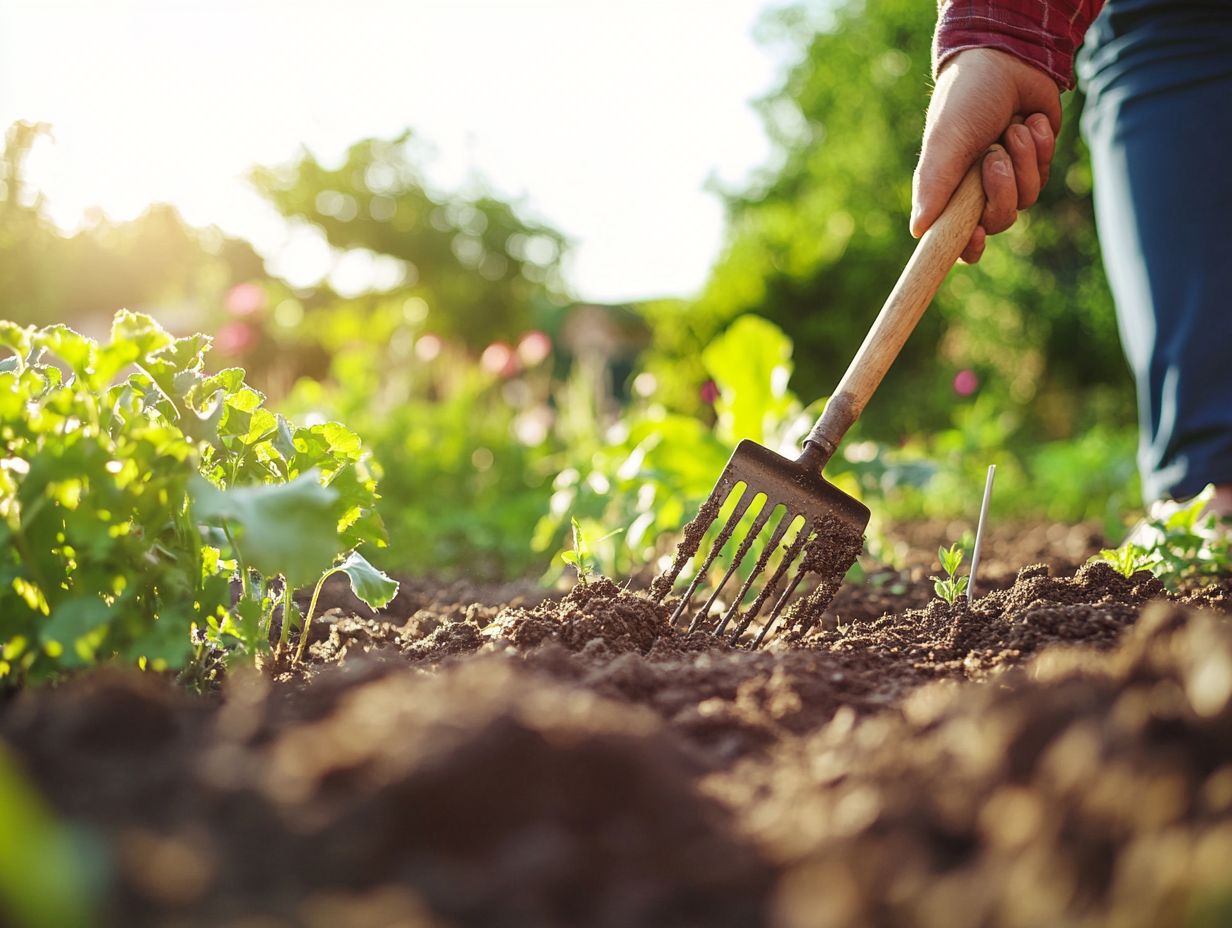
1. What are the benefits of improving soil aeration?
Improved soil aeration leads to better plant growth and health. It increases nutrient uptake and enhances soil structure and drainage.
2. What are some natural ways to improve soil aeration?
Incorporating organic matter such as compost, mulch, and cover crops helps improve soil aeration naturally over time.
3. What are the 5 methods for improving soil aeration?
The 5 methods include adding organic matter, tilling or aerating the soil, using materials you add to the soil to improve its quality, rotating crops, and avoiding over-watering.
4. Can tilling or aerating the soil improve soil aeration?
Yes, tilling or aerating the soil helps break up compacted soil. This increases pore space, allowing for better air and water movement.
5. How can soil amendments improve soil aeration?
Soil amendments such as gypsum and lime improve soil structure. This allows for better air movement and drainage.
6. Are there any specific plants or crops that can help improve soil aeration?
Certain plants, like legumes, have deep root systems that can break up compacted soil and improve aeration. Rotating crops helps prevent soil compaction and improve aeration.


